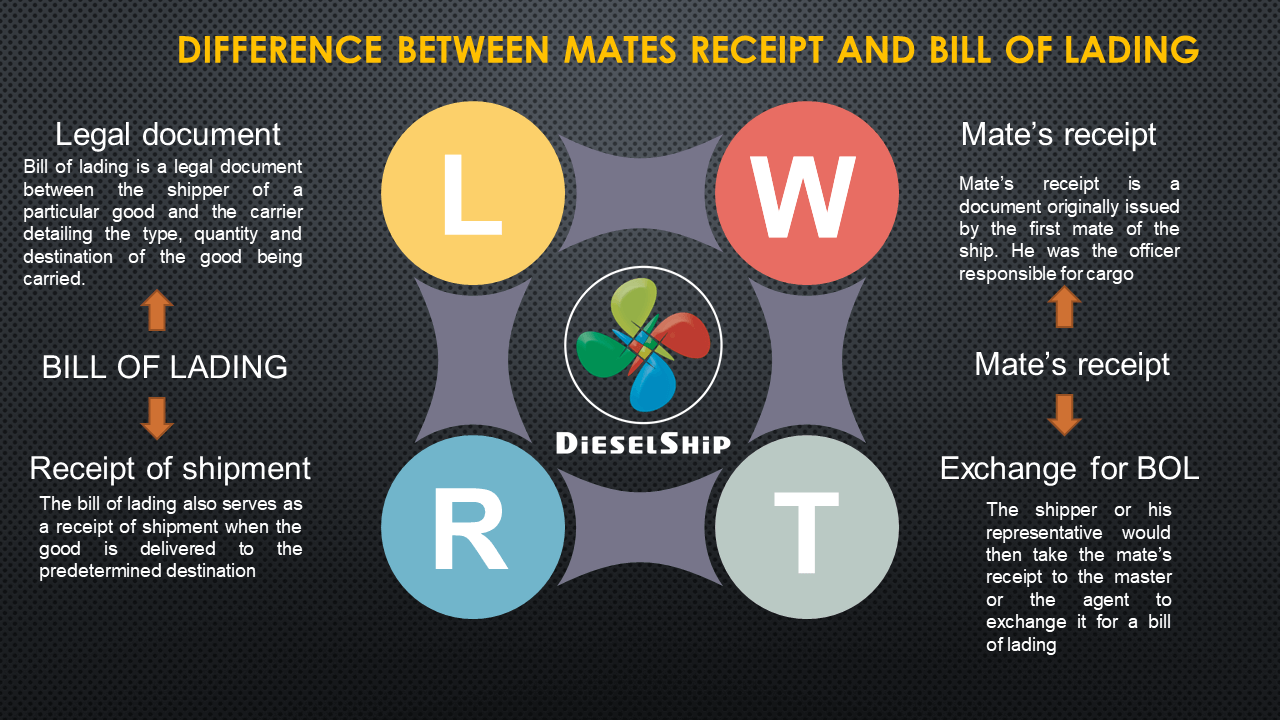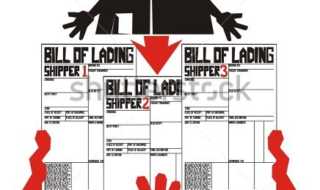Difference Between Mates Receipt And Bill Of Lading

Difference Between Mates Receipt And Bill Of Lading
Before we get into the difference between mates receipt and bill of lading let us first understand what is Bill of lading and Mates’ receipt.
Bill of lading is a legal document between the shipper of a particular good and the carrier detailing the type, quantity and destination of the good being carried. The bill of lading also serves as a receipt of shipment when the good is delivered to the predetermined destination. This document must accompany the shipped goods, no matter the form of transportation, and must be signed by an authorized representative from the carrier, shipper and receiver.
Mate’s receipt is a document originally issued by the first mate of the ship. He was the officer responsible for cargo. The document would be issued by him after the cargo was tallied into the ship by tally clerks. The shipper or his representative would then take the mate’s receipt to the master or the agent to exchange it for a bill of lading, which would incorporate any conditions inserted into the mate’s receipt
| S.No | MATES RECEIPT | BILL OF LADING |
| 1 | Mate’s receipt is issued when goods are placed on board ship after verification of quantity and condition. | Bill of Lading is prepared & issued based on Mate’s receipt. |
| 2 | Mate’s Receipt is prepared and issued by chief officer. | B/L is issued by Master, or Agent, or Owner of the ship, or charterer. |
| 3 | Mate’s receipt simply acknowledges the receipt of goods inboard prior to carriage. It does not guarantee carriage of goods. | B/L acknowledges receipt of specified goods for carriage on board the particular ship. |
| 4 | Cargo maybe refused to carriage even after preparation of Mate’s Receipt. | Once B/L is prepared cargo must be carried unless refused for valid reasons.(Dangerous cargo, improper declaration, suspicious cargo, etc) |
| 5 | Mate’s Receipt is not evidence of existence of any contract of affreightment. | B/L is the evidence of existence of contract of affreightment. |
| 6 | Mate’s Receipt is prepared by chief officer in capacity of servant of Master. | B/L is signed by the Master in capacity of Agent of carrier. |
| 7 | Mate’s Receipt is not legal requirement but a procedural convenience. | B/L is a legal requirement in accordance with section 3 & 4 of Hague-Visby rules ( COGSA 1925) |
| 8 | Mate’s Receipt is not a legal document and is not admissible as evidence in court of law. | B/L is legal document. It is admissible in court of law even in absence of person who has signed it. |
| 9 | Mate’s receipt does not bind carrier. | B/L binds the carrier. |
| 10 | Mate’s Receipt is a temporary document prepared for the purpose of verifying cargo when it is brought onboard. | B/L is a permanent document. |
| 11 | Mate’s Receipt may be destroyed once B/L is prepared. | B/L must be preserved for a period of 3 years from the date of delivery of cargo or the cargo claims are settled which ever is later. |
| 12 | Mate’s Receipt is not a negotiable document. | B/L is a negotiable document unless specifically barred. |
| 13 | Mate’s Receipt is inferior document to B/L. | B/L is superior document to Mate’s Receipt. In case of any disputes between Mate’s Receipt and B/L as to quantity or quality of cargo, the B/L will prevail. |
| 14 | Cargo cannot be delivered against Mate’s Reciept. | Cargo must be delivered against B/L. |
| 15 | Mate’s Receipt does not give title to goods. | B/L gives right to title to the goods. |
| 16 | Holder of Mate’s Receipt is not owner of goods. | Bonafide holder of B/L is the owner of goods described therein. |
| 17 | Mate’s Receipt does not give right to cargo claims. | B/L gives right to cargo claims. |




Very nicely explained.
Although the mates receipt is inferior or primitive document, The Bill of Lading can not put any new remarks about cargo condition.
The MR must accommodate the cargo quality and then it is automatically transferred on BL.
Because in the port of discharge the cargo surveyor will scrutinize the condition of cargo and huge claim will come on carrier.
For example an expensive car loaded and clear MR & B/L is issued and during discharge the car found damaged (as if, it was intentionally damaged on board while transit!!!). This might result in huge claim in discharge port.
In order to protect the owner of carrier, we put remarks on MR (then transferred to B/L ). So MR is foundation and B/L is Legal reflection.
Thank you very much.